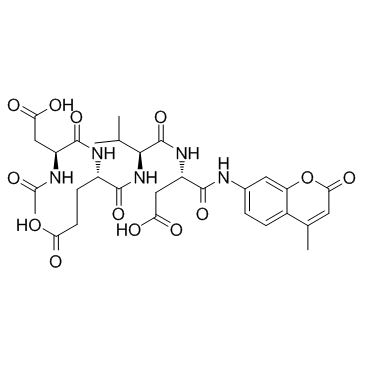Ac-Asp-Glu-Val-Asp-AMC ammonium salt

Ac-Asp-Glu-Val-Asp-AMC ammonium salt structure
|
Common Name | Ac-Asp-Glu-Val-Asp-AMC ammonium salt | ||
|---|---|---|---|---|
| CAS Number | 169332-61-0 | Molecular Weight | 675.641 | |
| Density | 1.4±0.1 g/cm3 | Boiling Point | 1200.1±65.0 °C at 760 mmHg | |
| Molecular Formula | C30H37N5O13 | Melting Point | N/A | |
| MSDS | USA | Flash Point | 679.6±34.3 °C | |
Use of Ac-Asp-Glu-Val-Asp-AMC ammonium saltAc-DEVD-AMC is the Caspase-3 substrate. Sequence: N-Acetyl-Asp-Glu-Val-Asp-7-amido-4-Methylcoumarin. |
| Name | N-Acetyl-Asp-Glu-Val-Asp-7-amido-4-methylcoumarin |
|---|---|
| Synonym | More Synonyms |
| Description | Ac-DEVD-AMC is the Caspase-3 substrate. Sequence: N-Acetyl-Asp-Glu-Val-Asp-7-amido-4-Methylcoumarin. |
|---|---|
| Related Catalog | |
| In Vitro | Ac-DEVD-AMC is the caspase-3 substrate and could be used to monitor intracellular caspase-3 activity[1].The AMC moiety is highest at 2 h (area =5.6±1.8), the AMC peak area for Ac-DEVD-AMC incubated without lung specimen (substrate alone) for 6 h is relatively small[2]. |
| Cell Assay | Lung fragments (about 20 mg each) are collected from rats and mice. The samples are incubated at 37°C in 50 mL KH buffer or MEM (continuously gass with 95% O2 : 5% CO2) for up to 6 h. At specific time points, samples are incubated in oxygenated KH buffer or MEM with 32 μM zVAD-fmk or 15 μL DMSO for 20 min (f/v=1.0 mL). Ac-DEVD-AMC (37 μM) is then added and the incubation continues for additional 20 min. At the end of incubation, the tissue is disrupted by vigorous homogenization for 2 min, sonication for 3 min and 10 passages through a 27-G needle. This disruption procedure quenches the Ac-DEVD-AMC cleavage reaction due to dilution. The supernatants are collected by centrifugation (~6,300g for 90 min) through microcentrifuge filter, separateed on HPLC, and analyzed for the fluorogenic AMC moiety[2]. |
| References |
| Density | 1.4±0.1 g/cm3 |
|---|---|
| Boiling Point | 1200.1±65.0 °C at 760 mmHg |
| Molecular Formula | C30H37N5O13 |
| Molecular Weight | 675.641 |
| Flash Point | 679.6±34.3 °C |
| Exact Mass | 675.238770 |
| PSA | 287.61000 |
| LogP | 1.07 |
| Vapour Pressure | 0.0±0.3 mmHg at 25°C |
| Index of Refraction | 1.594 |
| InChIKey | ALZSTTDFHZHSCA-RNVDEAKXSA-N |
| SMILES | CC(=O)NC(CC(=O)O)C(=O)NC(CCC(=O)O)C(=O)NC(C(=O)NC(CC(=O)O)C(=O)Nc1ccc2c(C)cc(=O)oc2c1)C(C)C |
| Storage condition | −20°C |
| Water Solubility | DMSO: 10 mM |
| Personal Protective Equipment | Eyeshields;Gloves;type N95 (US);type P1 (EN143) respirator filter |
|---|---|
| RIDADR | NONH for all modes of transport |
| WGK Germany | 3 |
|
RETRA exerts anticancer activity in Ewing's sarcoma cells independent of their TP53 status.
Eur. J. Cancer 51(7) , 841-51, (2015) Mutant p53 can exert oncogenic activity by inhibitory interaction with p73. The small-molecule RETRA has been described to disrupt this interaction and to suppress carcinoma cells (Kravchenko et al., ... |
|
|
Neuroprotection of atractylenolide III from Atractylodis macrocephalae against glutamate-induced neuronal apoptosis via inhibiting caspase signaling pathway.
Neurochem. Res. 39(9) , 1753-8, (2014) Glutamate-induced excitotoxicity appears to play a crucial role in neurological disorders. Neuroprotection against glutamate-induced excitotoxicity has been proposed as a therapeutic strategy for prev... |
|
|
Synergistic apoptosis-inducing effects on A375 human melanoma cells of natural borneol and curcumin.
PLoS ONE 9(6) , e101277, (2014) This study was to investigate the synergistic effect of NB/Cur on growth and apoptosis in A375 human melanoma cell line by MTT assay, flow cytometry and Western blotting. Our results demonstrated that... |
| 4-[(2-acetamido-3-carboxypropanoyl)amino]-5-[[1-[[3-carboxy-1-[(4-methyl-2-oxochromen-7-yl)amino]-1-oxopropan-2-yl]amino]-3-methyl-1-oxobutan-2-yl]amino]-5-oxopentanoic acid |
| Ac-DEVD-AMC |
| MFCD00671411 |
| L-α-Asparagine, N-acetyl-L-α-aspartyl-L-α-glutamyl-L-valyl-N-(4-methyl-2-oxo-2H-1-benzopyran-7-yl)- |
| N-Acetyl-L-α-aspartyl-L-α-glutamyl-L-valyl-N-(4-methyl-2-oxo-2H-chromen-7-yl)-L-α-asparagine |